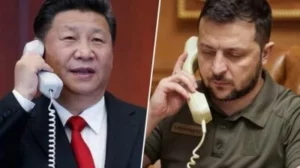What China Is Really Playing at in Ukraine
BRICS, 8 May 2023
Pepe Escobar | Strategic Culture Foundation – TRANSCEND Media Service
Beijing is fully aware the NATO proxy war against Russia in Ukraine is the un-dissociable double of the U.S. war against its Belt and Road Initiative.
30 Apr 2023 – Imagine President Xi Jinping mustering undiluted Taoist patience to suffer through a phone call with that warmongering actor in a sweaty T-shirt in Kiev while attempting to teach him a few facts of life – complete with the promise of sending a high-level Chinese delegation to Ukraine to discuss “peace”.
There’s way more than meets the discerning eye obscured by this spun-to-death diplomatic “victory” – at least from the point of view of NATOstan.
The question is inevitable: what’s the point of this phone call? Very simple: just business.
The Beijing leadership is fully aware the NATO proxy war against Russia in Ukraine is the un-dissociable double of an American direct war against the Belt and Road Initiative (BRI).
Until recently, and since 2019, Beijing was the top trade partner for Kiev (14.4% of imports, 15.3% of exports). China essentially exported machinery, equipment, cars and chemical products, importing food products, metals and also some machinery.
Very few in the West know that Ukraine joined BRI way back in 2014, and a BRI trade and investment center was operating in Kiev since 2018. BRI projects include a 2017 drive to build the fourth line of the Kiev metro system as well as 4G installed by Huawei. Everything is stalled since 2022.
Noble Agri, a subsidiary of COFCO (China National Cereals, Oils and Foodstuffs Corporation), invested in a sunflower seed processing complex in Mariupol and the recently built Mykolaiv grain port terminal. The next step will necessarily feature cooperation between Donbass authorities and the Chinese when it comes to rebuilding their assets that may have been damaged during the war.
Beijing also tried to become heavily involved in the Ukraine defense sector and even buy Motor Sich; that was blocked by Kiev.
Watch that neon
So what we have in Ukraine, from the Chinese point of view, is a trade/investment cocktail of BRI, railways, military supplies, 4G and construction jobs. And then, the key vector: neon.
Roughly half of neon used in the production of semiconductors was supplied, until recently, by two Ukrainian companies; Ingas in Mariupol, and Cryoin, in Odessa. There’s no business going on since the start of the Special Military Operation (SMO). That directly affects the Chinese production of semiconductors. Bets can be made that the Hegemon is not exactly losing sleep over this predicament.
Ukraine does represent value for China as a BRI crossroads. The war is interrupting not only business but, in the bigger picture, one of the trade and connectivity corridors linking Western China to Eastern Europe. BRI conditions all key decisions in Beijing – as it is the overarching concept of Chinese foreign policy way into mid-century.
And that explains Xi’s phone call, debunking any NATOstan nonsense on China finally paying attention to the warmongering actor.
As relevant as BRI is the overarching bilateral relationship dictating Beijing’s geopolitics: the Russia-China comprehensive strategic partnership.
So let’s transition to the meeting of Defense Ministers of the Shanghai Cooperation Organization (SCO) earlier this week in Delhi.
The key meeting in India was between Russian Defense Minister Sergei Shoigu and his Chinese colleague Li Shangfu. Li was recently in Moscow, and was received by Putin in person for a special conversation. This time he invited Shoigu to visit Beijing, and that was promptly accepted.
Needless to add that every single player in the SCO and beyond, including nations that are for the moment just observers or dialogue partners as well as others itching to become full members, such as Saudi Arabia, paid very close attention to the Shoigu-Shangfu camaraderie.
When it comes to the profoundly strategic Central Asian “stans”, that represents the six feet under treatment for the Hegemon wishful thinking of using them in a Divide and Rule scheme pitting Russia against China.
Shoigu-Shangfu also sent a subtle message to SCO members India and Pakistan – stop bickering and in the case of Delhi, hedging your bets – and to full member (in 2023) Iran and near future member Saudi Arabia: here’s where’s it at, this the table that matters.
All of the above also points to the increasing interconnection between BRI and SCO, both under Russia-China leadership.
BRICS is essentially an economic club – complete with its own bank, the NDB – and focused on trade. It’s mostly about soft power. The SCO is focused on security. It’s about hard power. Together, these are the two key organizations that will be paving the multilateral way.
As for what will be left of Ukraine, it is already being bought by Western mega-players such as BlackRock, Cargill and Monsanto. Yet Beijing certainly does not count on being left high and dry. Stranger things have happened than a future rump Ukraine positioned as a functioning trade and connectivity BRI partner.
_______________________________________________
 Pepe Escobar, born in Brazil, is a correspondent and editor-at-large at Asia Times and columnist for Consortium News and Strategic Culture in Moscow. Since the mid-1980s he’s lived and worked as a foreign correspondent in London, Paris, Milan, Los Angeles, Singapore, and Bangkok. He has extensively covered Pakistan, Afghanistan and Central Asia to China, Iran, Iraq and the wider Middle East. He is the author of Globalistan (2007), Red Zone Blues (2007), Obama Does Globalistan (2009), Empire of Chaos (2014) and 2030 (2015), all by Nimble Books. Pepe was contributing editor to The Empire and The Crescent and Tutto in Vendita in Italy and is also associated with the Paris-based European Academy of Geopolitics. When not on the road he lives between Paris and Bangkok.
Pepe Escobar, born in Brazil, is a correspondent and editor-at-large at Asia Times and columnist for Consortium News and Strategic Culture in Moscow. Since the mid-1980s he’s lived and worked as a foreign correspondent in London, Paris, Milan, Los Angeles, Singapore, and Bangkok. He has extensively covered Pakistan, Afghanistan and Central Asia to China, Iran, Iraq and the wider Middle East. He is the author of Globalistan (2007), Red Zone Blues (2007), Obama Does Globalistan (2009), Empire of Chaos (2014) and 2030 (2015), all by Nimble Books. Pepe was contributing editor to The Empire and The Crescent and Tutto in Vendita in Italy and is also associated with the Paris-based European Academy of Geopolitics. When not on the road he lives between Paris and Bangkok.
Go to Original – strategic-culture.org
Tags: Anglo America, Anti-imperialism, Belt and Road, Bullying, China, Cold War III, Hegemony, NATO, Proxy War, Russia, South China Sea, Taiwan, USA, Ukraine
DISCLAIMER: The statements, views and opinions expressed in pieces republished here are solely those of the authors and do not necessarily represent those of TMS. In accordance with title 17 U.S.C. section 107, this material is distributed without profit to those who have expressed a prior interest in receiving the included information for research and educational purposes. TMS has no affiliation whatsoever with the originator of this article nor is TMS endorsed or sponsored by the originator. “GO TO ORIGINAL” links are provided as a convenience to our readers and allow for verification of authenticity. However, as originating pages are often updated by their originating host sites, the versions posted may not match the versions our readers view when clicking the “GO TO ORIGINAL” links. This site contains copyrighted material the use of which has not always been specifically authorized by the copyright owner. We are making such material available in our efforts to advance understanding of environmental, political, human rights, economic, democracy, scientific, and social justice issues, etc. We believe this constitutes a ‘fair use’ of any such copyrighted material as provided for in section 107 of the US Copyright Law. In accordance with Title 17 U.S.C. Section 107, the material on this site is distributed without profit to those who have expressed a prior interest in receiving the included information for research and educational purposes. For more information go to: http://www.law.cornell.edu/uscode/17/107.shtml. If you wish to use copyrighted material from this site for purposes of your own that go beyond ‘fair use’, you must obtain permission from the copyright owner.
